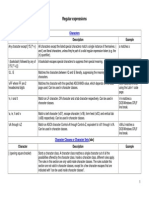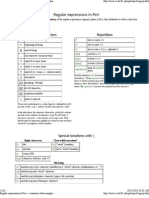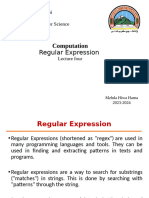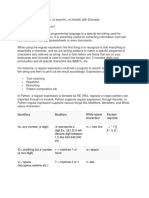Python Regex Cheatsheet With Examples: Re Module Functions
Uploaded by
Anonymous jyMAzN8EQPython Regex Cheatsheet With Examples: Re Module Functions
Uploaded by
Anonymous jyMAzN8EQPython RegEx C h e a ts h e e t with Examples
A RegEx, or Regular Expression, is a sequence of characters that forms a search pattern. They’re
typically used to find a sequence of characters within a string so you can extract and manipulate them.
For example, the following returns both instances of ‘active’:
import re
pattern = 'ac..ve'
test_string = 'my activestate platform account is now active'
result = re.findall(pattern, test_string)
RegExes are extremely useful, but the syntax can be hard to recall. With that in mind, ActiveState offers
this “cheatsheet” to help point you in the right direction when building RegExes in Python.
Special characters Special sequences
. match any char except newline \A match occurrence only at start of string
(eg., ac..ve) \Z match occurrence only at end of string
^ match at beginning of string match empty string at word boundary (e.g.,
(eg., ^active) \b between \w and \W)
$ match at end of string \B match empty string not at word boundary
(eg, state$) \d match a digit
[3a-c] match any char \D match a non-digit
(ie., 3 or a or b or c) \s match any whitespace char: [ \t\n\r\f\v]
[^x-z1] match any char except x, y, z or 1 \S match any non-whitespace char
A|S match either A or S regex \w match any alphanumeric: [0-9a-zA-Z_]
() capture & match a group of chars \W match any non-alphanumeric
(eg., (8097ba)) \g<id> matches a previously captured group
\ escape special characters (?:A) match expression represented by A
(non-capture group)
Quantifiers A(?=B) match expression A only if followed by B
match 0 or more occurrences A(?!B) match expression A only if not followed by
*
(eg., py*) B
+
match 1 or more occurrences (?<=B)A match expression A only if it follows B
(eg., py+) match expression A only if not preceded by
?
match 0 or 1 occurrences (?<!B)A B
(eg., py?)
(?aiLmsux) where a, i, L, m, s, u, and x are flags:
match exactly m occurrences
{m} (eg., py{3}) a = match ASCII only
i = make matches ignore case
match from m to n occurrences
{m,n} (eg., py{1,3}) L = make matches locale dependent
m = multi-line makes ^ and $ match at the
match from 0 to n occurrences
{,n} (eg., py{,3}) beginning/end of each line, respectively
match m to infinite occurrences
s = makes ‘.’ match any char including newline
{m,} (eg., py{3,}) u = match unicode only
match m to n occurrences, x = verbose increases legibility by allowing
{m,n} but as few as possible (eg., py{1,3}?) comments & ignoring most whitespace
re Module Functions
Besides enabling the above functionality, the ‘re’ module also features a number of popular functions:
re.findall(A, B) match all occurrences of expression A in string B
re.search(A, B) match the first occurrence of expression A in string B
re.split(A, B) split string B into a list using the delimiter A
re.sub(A, B, C) replace A with B in string C
Need more help?
Read the documentation here:
www.activestate.com https://docs.python.org/3/library/re.html
You might also like
- Literacy: Bass Clef Transposition Worksheet 1: Higher MusicNo ratings yetLiteracy: Bass Clef Transposition Worksheet 1: Higher Music6 pages
- Python Regular Expressions Cheat Sheet PDFNo ratings yetPython Regular Expressions Cheat Sheet PDF1 page
- Chimichangasguy - Python Regular Expressions - BW PDFNo ratings yetChimichangasguy - Python Regular Expressions - BW PDF1 page
- Regular Expressions Cheat Sheet v1 (AddedBytes)[RegEx] #No ratings yetRegular Expressions Cheat Sheet v1 (AddedBytes)[RegEx] #1 page
- MMW Mathematical Language Sets Logic Part2No ratings yetMMW Mathematical Language Sets Logic Part239 pages
- A Quick Introduction To Regular Expressions in JavaNo ratings yetA Quick Introduction To Regular Expressions in Java7 pages
- Metacharacters For Regular Expressions in PerlNo ratings yetMetacharacters For Regular Expressions in Perl1 page
- Regular Expressions: Regular Expression Syntax in PythonNo ratings yetRegular Expressions: Regular Expression Syntax in Python11 pages
- Python Regex: Re - Match, Re - Search, Re - Findall With ExampleNo ratings yetPython Regex: Re - Match, Re - Search, Re - Findall With Example10 pages
- Shipping Report - Weight Diff Report - 01.04.2016No ratings yetShipping Report - Weight Diff Report - 01.04.201644 pages
- Shipper VGM Declaration Form - ExpeditorsNo ratings yetShipper VGM Declaration Form - Expeditors2 pages
- Grade K Developmental Stages of Writing English SpanishNo ratings yetGrade K Developmental Stages of Writing English Spanish1 page
- Leksioni1 Final2023 - Elementet e Informatikes - Bojken ShehuNo ratings yetLeksioni1 Final2023 - Elementet e Informatikes - Bojken Shehu48 pages
- Department of Education: Region V - Bicol Schools Division Office Daet, Camarines NorteNo ratings yetDepartment of Education: Region V - Bicol Schools Division Office Daet, Camarines Norte10 pages





























































































